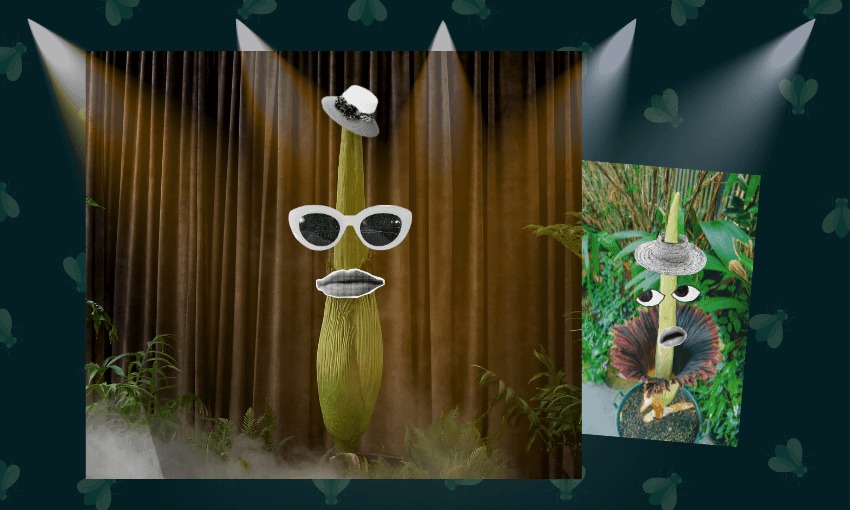Are we too modest when it comes to celebrating our putrid plant life?
She’s beauty. She’s grace. She smells like a decaying corpse and lurks in the backrooms of Auckland Zoo, wallowing tragically in a bucket.
In recent weeks an Australian corpse plant named Putricia has captured the noses and imaginations of thousands around the world. She’s had a livestream, at least 15,000 guests lining up before even unfurling, and a piece in Vogue, where she’s been named “The Internet’s Stinkiest It Girl”. And in New York, another corpse plant had people queueing in the cold for hours to catch a whiff.
Meanwhile, one of New Zealand’s own Putricias languishes in obscurity. She has no name. She has no fanfare, no velvet curtain, no cultish devotees. She was kept in the ectotherms team room, says a source, “ominously growing” in a bucket (“we hoped it moved before it was stinky”). She was briefly on display, then relegated to an industrial aquarist pump room.
Last December, she bloomed her little heart out, exuding her effervescent pong to the world. Harold*, an employee at Auckland Zoo, recalls three people lining up. He was one of them.
She smelled like shart, Harold says, especially in the evenings, when her tip engorges and becomes more pungent. People wanted to sniff her. Many just didn’t know she was there.
“There were people calling asking just to see the plant – and people getting angry after us taking it off display. People don’t realise they only bloom for three to five days – five is lucky – until the tip starts to sag.” Harold continues talking about her smelly, swollen tip for a while longer.
New Zealand has had some corpse plants proudly on display. The Auckland Wintergardens amorphophallus attracted “hundreds” of visitors when it bloomed in 2020, described as smelling of “dead rat, but with added sulphurous odours with faeces”. In 2021, I was one of thousands in Dunedin lining up in the Botanic Gardens for a precious whiff. To my knowledge, none of these plants have had names.
Using a PI and some hired goons, I tracked down the Auckland Zoo corpse plant’s dad. Ben Goodwin, now a lecturer, was an ectotherms keeper at the zoo, and grows amorphophallus (meaning “deformed penis”) species as a hobby. He obtained her from a seed donor on Facebook, though isn’t sure where they got it from – perhaps imported. When she got too big, he left to buy milk and never came back.
“I don’t really miss the amorphophallus,” he says, ruthlessly. “I owned it, but I kept it at work nearly the entire time it was mine. It was just too big and too demanding of a specialised habitat – real hot, real humid – to grow at home.”
“They did put it on display when it flowered last year, but they didn’t really seem to make much of a big deal about it,” he explains. There were a couple of social media posts, and they had the flower on display for a while, but then it all blew over. “It should have been much bigger news,” Goodwin says. “I’m sure they realise this now and hopefully won’t be caught out next time it flowers.” (This possibly will happen within the next few decades, so hold onto your britches.)
The issue, Goodwin reckons, is that “zoos are too fixed on animals.”
“I don’t think plants are perceived as having the same level of interest to the public, but plants are just as interesting as animals and just as worthy of attention. Auckland Zoo has an incredible collection of plants, but the gardens are treated as a backdrop to the animals rather than something significant in their own right.”
In the 1900s, zoos became more naturalistic, using habitat design to create an immersive space for both animal and visitor. I recall some positive feedback from a guest at Wellington Zoo, who’d not seen many animals but greatly enjoyed her inner-city bushwalk nonetheless. When walking through Auckland Zoo, it’s likewise easy to forget you aren’t really in the South American rainforest, but instead at Western Springs.
Flowering amorphophallus are probably the biggest single draw cards for public plant collections, says Goodwin (see: season 14, episode 22 of The Simpsons, ‘Moe Baby Blues‘). “There are well documented examples of extremely high visitation for botanic gardens all over the world … I’ve spent my whole career trying to get people interested in less charismatic animals and plants. I think everyone should enjoy all parts of the natural world, not just the showy stuff. It’s all interconnected.”
I think back to Joel MacManus’s brave condemnation of the bucket fountain, decrying it as a symbol of New Zealand, understated and self deprecating. Why do our Putricias not deserve adoring flocks of fans? Where are her velvet ropes and curtains?
In reality, zookeeping is mental, and there’s little time to prioritise a plant when over 2800 animals need husbandry. I do not, at all, blame Auckland Zoo, which is a world-leading facility in conservation and animal care (hire me please). I do think that we should give ourselves freedom to be vainglorious, extravagant, and camp. Let’s embrace our weird little freaks. Wherever she is, and whoever she is, I hope our next Putricia gets the stinky fame she deserves.
